Overview
This article underscores the critical importance of effectively purchasing a bug out bag. It outlines essential factors to consider—size, durability, comfort, and the specific needs of the individual or family. Selecting the right bag and personalizing its contents are not just steps; they are crucial components of ensuring preparedness for emergencies. Expert recommendations and real-life examples of successful preparedness strategies further support this assertion. Are you ready to take the necessary steps to safeguard yourself and your loved ones? Your preparedness journey begins with the right choices.
Introduction
In an unpredictable world, the importance of being prepared for emergencies cannot be overstated. A bug out bag (BOB) serves as a lifeline, containing essential supplies that can sustain individuals for at least 72 hours during an unexpected evacuation. Are you ready to face natural disasters, civil unrest, or other perilous situations? Understanding how to effectively assemble and personalize a bug out bag is crucial for ensuring safety and resilience.
From selecting the right gear to tailoring contents for specific needs, this comprehensive guide delves into the key factors that enhance preparedness. Empower yourself to navigate crises with confidence and clarity.
Draft
1. Understanding the Bug Out Bag: Definition and Purpose
A bug out bag (BOB) is a portable kit designed to ensure survival for at least 72 hours during a crisis evacuation. Its primary purpose is to equip individuals with the necessary tools and resources to sustain themselves during a rapid departure from home—whether due to natural disasters, civil unrest, or other situations where remaining in place poses a risk. Understanding the definition and purpose of a bug out bag is crucial for effective preparedness against unforeseen circumstances.
Key Features of a Bug Out Bag
Portability: A bug out bag is specifically designed for easy transport, typically in a durable backpack that allows for mobility during emergencies. This feature is vital; a well-packed bag should ideally weigh between 20 to 25 pounds, ensuring that it is manageable for quick escapes.
Essential Supplies: The contents of a bug out bag are critical for survival and should include food, water, first aid supplies, and other necessary items tailored to individual needs. For instance, prescription medications are vital components that require careful consideration regarding storage and rotation to ensure they remain effective when needed.
Quick Access: In high-stress situations, the organization of items within the bag is paramount. Supplies should be arranged for rapid retrieval, allowing individuals to focus on their safety rather than searching for essential gear.
Real-life instances underscore the importance of having a bug out bag ready for critical situations. During recent natural disasters, many individuals who were prepared with well-stocked emergency kits reported a smoother evacuation process. This highlights the effectiveness of having a plan in place. Moreover, expert opinions emphasize that to effectively prepare for emergencies, one should invest in a bug out bag; it is not merely a collection of items but a vital part of a thorough crisis response plan.
As noted by Virginia Murray from Public Health England, 'A well-prepared bug out bag can significantly enhance personal safety and resilience during crises.'
The case study named 'Frequently Asked Questions' elucidates the concept of bug out kits and offers advice on assembling one tailored to personal requirements, reinforcing the significance of individual readiness. In 2025, the importance of evacuation packs is growing, with many families recognizing the value of those who invest in a bug out bag for crisis readiness. This trend reflects a broader understanding of the need for proactive planning in an increasingly unpredictable world.
Additionally, insights from Karen Reddin in the Emergency Response Department at Public Health England emphasize the continued necessity for readiness in crisis situations.
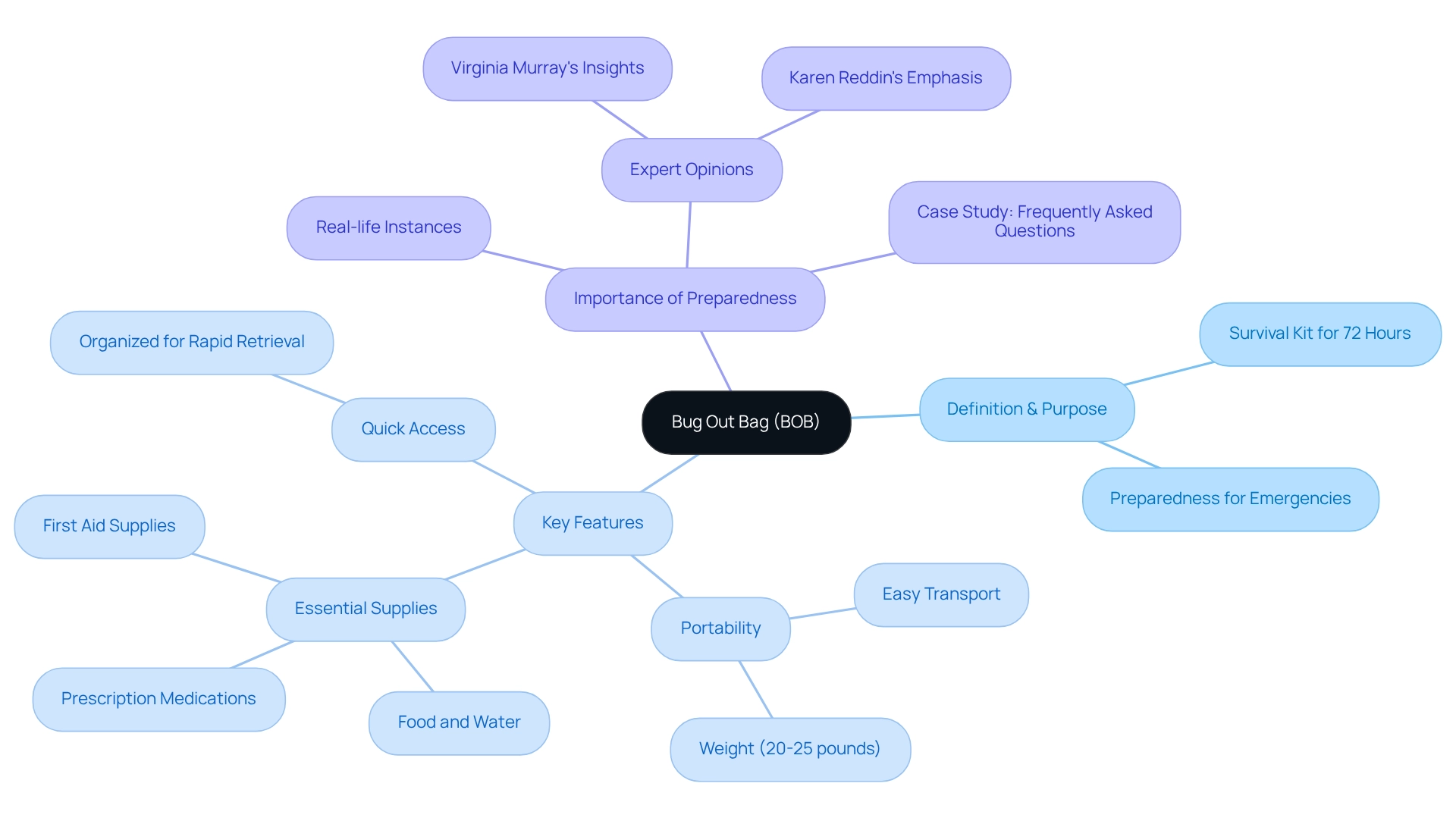
Central node represents the bug out bag, with branches denoting its definition, key features, and importance, color-coded for easy identification.
2. Key Factors to Consider When Choosing a Bug Out Bag
When selecting a bug out bag, several key factors should guide your decision-making process:
Size and Capacity: Choosing a bag that can accommodate all necessary items without becoming overly cumbersome is crucial. For a 72-hour kit, a capacity of 40-60 liters is generally recommended, allowing for sufficient storage of essentials while maintaining portability. Remember, your food supply should last for 3 days per person, underscoring the importance of adequate capacity when purchasing a bug out bag.

Durability: The materials used in a bug out bag must withstand extreme conditions. Look for water-resistant fabrics and reinforced stitching, essential for ensuring longevity and reliability in harsh environments. High-quality materials significantly enhance the durability of bug out bags, making it a worthwhile investment.
Comfort: When deciding on a bug out bag, comfort is paramount, especially if you need to carry it over long distances. Ensure that the bag features padded shoulder straps and a hip belt to facilitate better weight distribution, reducing strain on your body during an evacuation.
Accessibility: To ensure quick access to essential items, select a well-designed bug out bag. Consider options with front-loading compartments or side pockets that enable you to reach critical supplies without rummaging through the entire bag. Additionally, having a lightweight backpack stove with fuel canisters is important for food preparation, as fire may not always be practical.
Weight: Opt for a lightweight bag to minimize unnecessary strain. A bag that is too heavy can hinder your mobility and effectiveness during a crisis. For instance, the Kifaru Minikeg, a military-grade roll-top backpack made from premium materials, weighs less than 4 lbs while offering nearly 46 liters of storage. Despite its high price and limited organizational amenities, it is recognized as an exceptional choice due to its ruggedness and lightweight design. Creek Stewart, a Wilderness Survival Instructor, emphasizes the importance of packing essential gear, stating, "I personally pack a Katadyn Hiker Pro Filtration System, an Aquamira Survival Straw (as a backup), and sodium chlorite water purification tablets."
By carefully considering these factors, you can select a bug out bag that not only meets your needs but also enhances your preparedness for any situation.
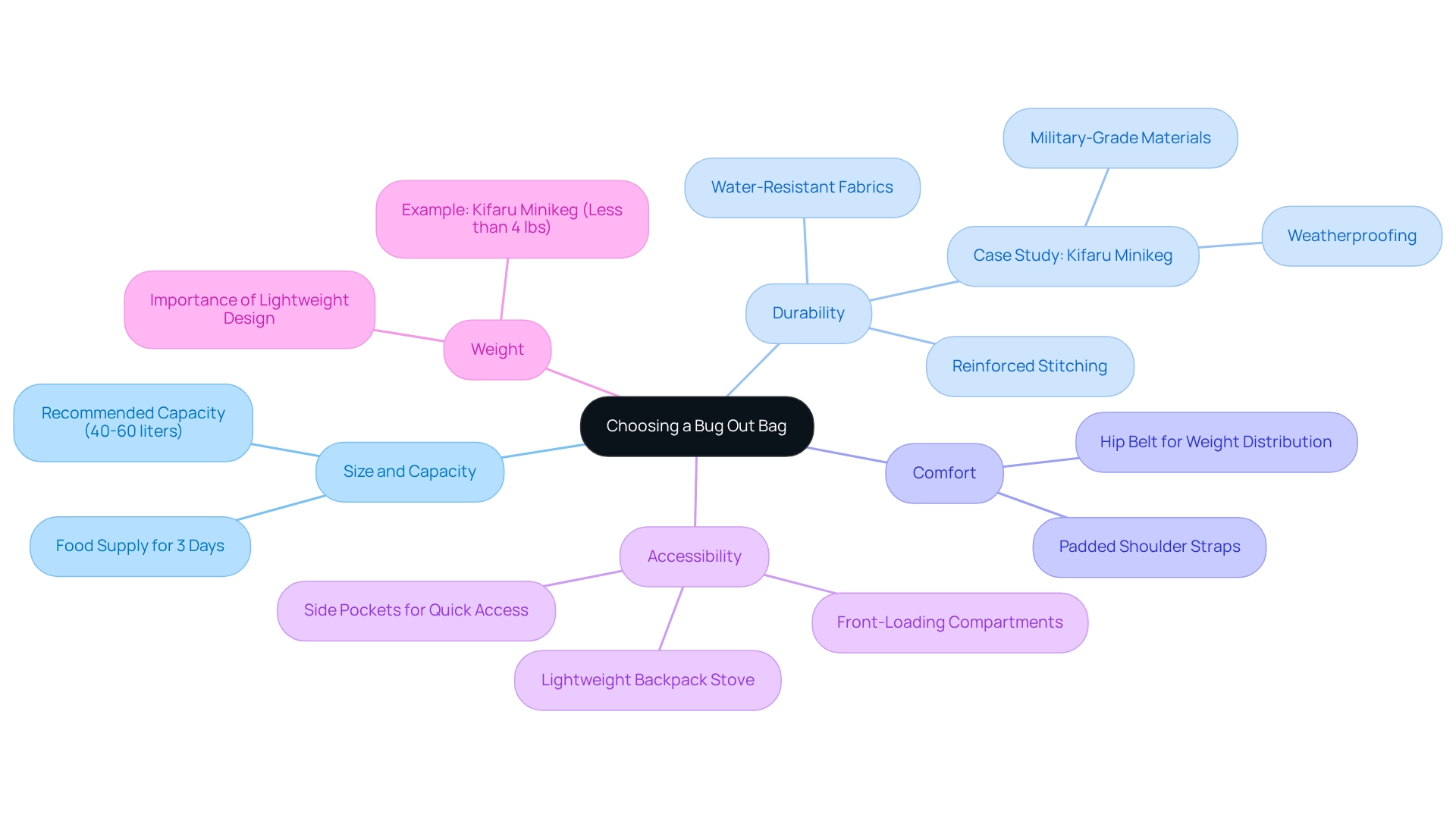
The central node represents the main theme, while branches represent key factors to consider when selecting a bug out bag, with sub-branches detailing specific considerations.
3. Exploring Different Types of Bug Out Bags: Which One is Right for You?
When considering a bug out bag, it is essential to understand the different types available, each designed for specific situations and environments.
Standard Bug Out Bag: This adaptable choice is designed for a variety of crises, typically filled with a balanced assortment of survival equipment, such as food, water, and first aid supplies. Its adaptability makes it a staple for many preppers.
Urban Bug Out Bag: Specifically designed for city dwellers, this bag focuses on navigating urban challenges. It comprises compact tools, personal safety equipment, and items that assist in navigating through crowded settings, making it perfect for situations in urban areas.
Family Bug Out Bag: Larger in size, this bag is tailored to accommodate the needs of multiple family members. It ensures that everyone has access to essential supplies, promoting a collective approach to preparedness during crises.
Vehicle Bug Out Bag: Kept in your car, this kit is essential for crises while traveling. It typically contains supplies that address immediate needs, such as food, water, and basic first aid, ensuring you're prepared no matter where you are.
Specialized Bug Out Packs: These packs cater to particular situations, such as wilderness survival or medical crises. They are equipped with specialized gear that addresses the unique challenges posed by these situations, enhancing your readiness for diverse emergencies.
Comprehending the differences between these kinds of emergency packs is crucial for effective readiness. Consider this: statistics indicate that urban emergency kits are increasingly popular, reflecting a growing awareness of the unique challenges faced in city environments. Recent market analyses indicate that urban emergency packs now represent a considerable portion of the emergency pack market, emphasizing their significance in contemporary planning strategies.
Moreover, it is vital to consider water treatment when purchasing a bug out bag. For effective purification, add eight drops of 6% bleach or six drops of 8.25% bleach to one gallon of water. This knowledge is essential for guaranteeing access to safe drinking water during crises.
Real-world examples further illustrate the necessity of having the right bag for the right situation. During a recent city emergency, individuals equipped with urban bug out bags reported greater ease in navigating obstacles and securing safety, underscoring the effectiveness of customized readiness solutions. Furthermore, the case study titled 'Evacuating or Bugging Out' reflects on the essential need for readiness during natural disasters, emphasizing the importance of having a well-prepared bug-out bag.
As you consider your options, remember that purchasing a bug out bag can make all the difference in ensuring safety and resilience during unpredictable events.
Finally, sharing prepping knowledge among individuals fosters a sense of community and collective preparedness, which is invaluable in times of crisis. As Jovanni Bello wisely stated, "Stay safe out there.
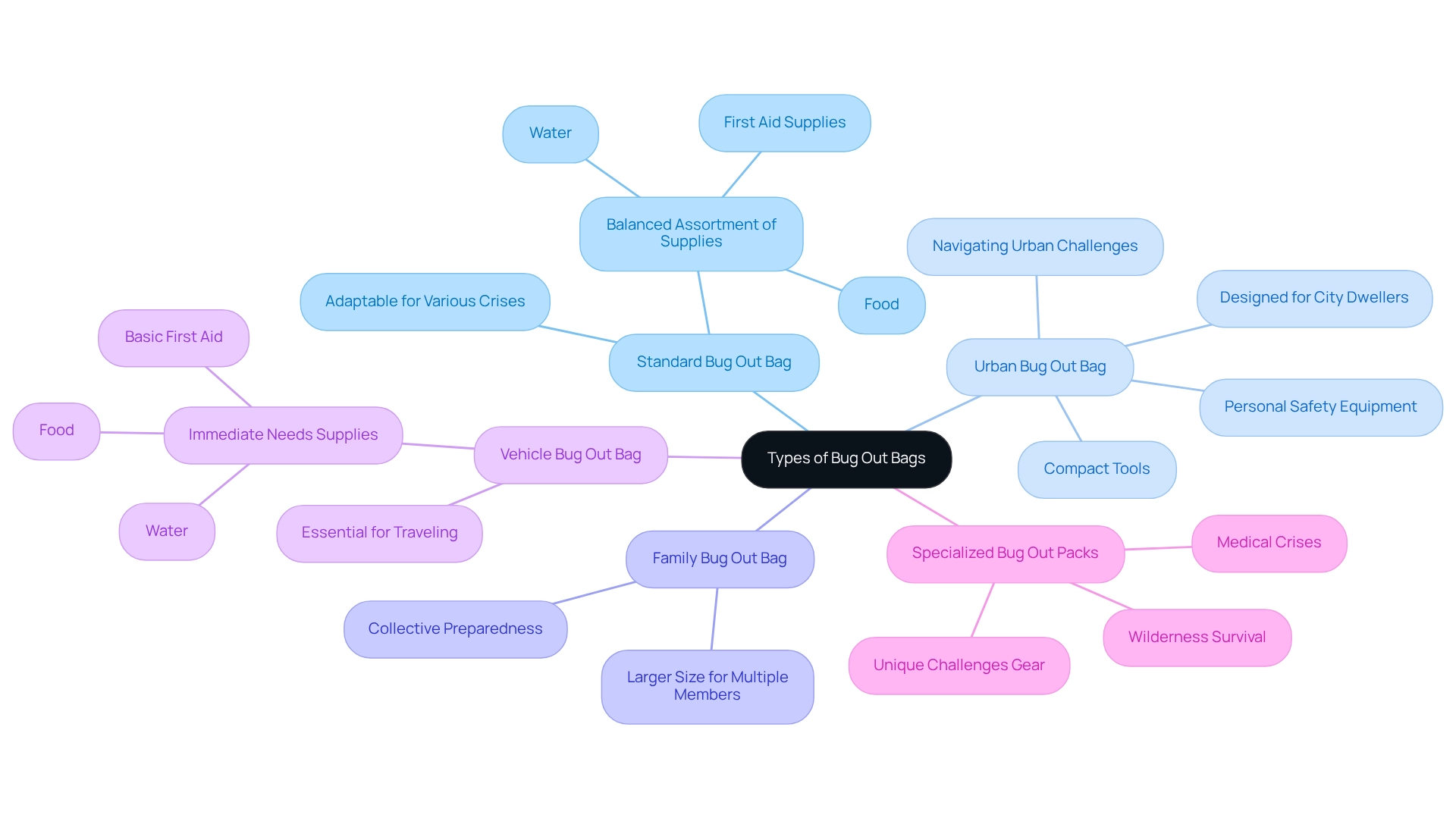
Each branch represents a type of bug out bag, with sub-branches detailing their specific features and intended uses.
4. Essential Gear: What to Pack in Your Bug Out Bag
When you invest in a bug out bag, including essential items is crucial for your survival in a crisis. Here’s a comprehensive checklist to guide your packing:
Water: Aim for at least one gallon per person per day, sufficient for three days. This is vital for hydration and can be supplemented with water purification tablets or filters.
Food: Pack non-perishable items that are high in caloric density, such as energy bars, freeze-dried meals, or MREs (Meals Ready-to-Eat). Consider the weight and shelf life of these items to maximize efficiency, as expert recommendations emphasize the importance of these factors in food selection.
First Aid Kit: A well-stocked first aid kit should include bandages, antiseptics, and any personal medications. Customize it to your particular health requirements to ensure you’re ready for any medical situations.
Multi-tool: A versatile multi-tool can serve multiple functions, from opening cans to making repairs, making it an indispensable item in your bag.
Flashlight: Include a reliable flashlight with extra batteries. This is essential for visibility during nighttime or low-light situations, and it can also be used for signaling. As emphasized in a case study on essential equipment, possessing a reliable flashlight is vital for navigation and safety during critical situations.
Fire Starter: Matches, lighters, or fire starters are crucial for warmth and cooking. Ensure they are waterproof or stored in a waterproof container to maintain functionality. A survival blanket, being lightweight and compact, can provide warmth and protection from the elements, making it a must-have item to buy for any bug out bag.
Clothing: Pack extra socks, underwear, and weather-appropriate gear. Layering is key to adapting to changing conditions.
Navigation Tools: Include a map and compass, or a GPS device. These tools are essential for finding your way in unfamiliar territory.
Personal Documents: Keep copies of important documents, such as identification and medical records, in a waterproof bag to protect them from the elements.
Incorporating these items into your bug out bag not only enhances your preparedness but also aligns with expert recommendations for survival gear in 2025. Statistics indicate that the most frequently included items in bug out bags often represent these essentials, highlighting their significance in critical situations. As survival instructor Aaron (Hutch) Hutchings advises, "Stay positive, stay safe, and I will see you again soon on the adventure trail."
Real-life examples of successful strategies for bug out bag packing underscore the effectiveness of these items in ensuring safety and self-reliance during crises.
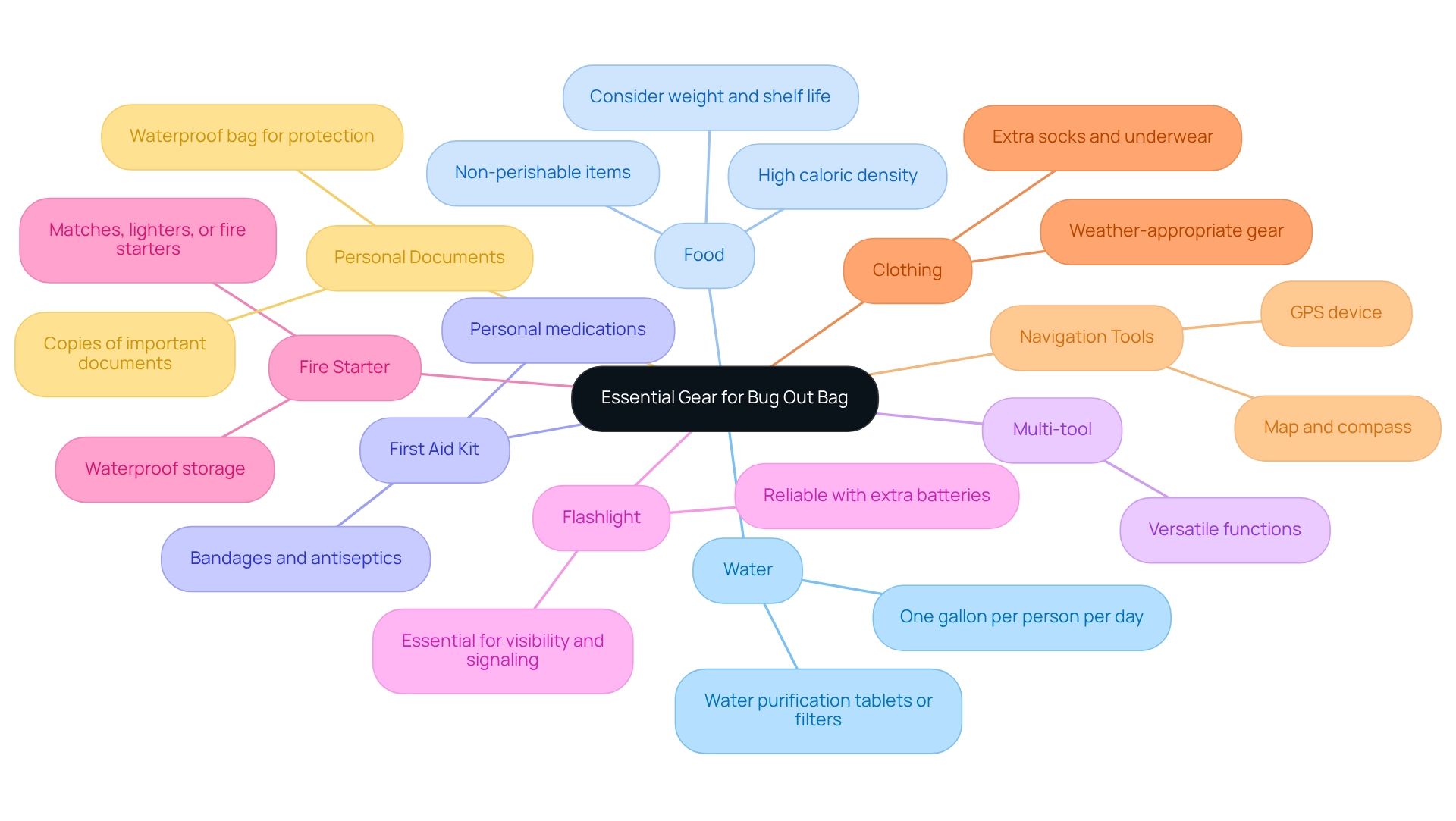
The central node represents the overall theme, with branches indicating the main categories of gear and sub-branches providing specific recommendations.
5. Personalizing Your Bug Out Bag: Making It Your Own
To effectively personalize your bug out bag, consider the following steps:
Assess Your Needs: Begin by evaluating your unique circumstances. What factors should you consider? Family size, health conditions, and specific risks prevalent in your area are crucial. This assessment will guide your choices in selecting essential items.
Add Personal Items: Incorporate items that cater to your individual needs. This may include necessary medications, baby supplies, or even pet food. Customizing your bag in this manner guarantees that you are prepared for the unique challenges your family might encounter during a crisis.
Choose Comfort Items: Including small comfort items can significantly boost morale during stressful situations. Think about packing a favorite snack, a family photo, or a cherished memento. Research indicates that such items can provide psychological benefits, helping to alleviate stress and maintain a sense of normalcy in chaotic circumstances.
Select Durable Materials: When you decide to buy a bug out bag, consider options like the GORUCK GR2, made from 1,000-denier CORDURA. This material is recognized for its durability, ensuring that your bag can endure the challenges of a critical situation.
Practice Packing: Regularly practice packing and unpacking your bag. This not only familiarizes you with the contents but also ensures you can do it quickly and efficiently when time is of the essence. Familiarity with your gear can make a critical difference in an emergency.
Update Regularly: It’s essential to review and update your bug out bag every six months. This allows you to replace expired items and adjust for any changing needs, ensuring that your bag remains relevant and effective. Statistics indicate that survivalists who customize their bug out bags express greater confidence in their readiness, emphasizing the significance of this practice.
Consider Quality Options: For those looking to buy a bug out bag, the Kifaru Minikeg is a premium military-grade roll-top backpack designed for bugout use. Its superior construction and versatility make it an excellent choice for personalizing your gear.
By following these steps, you can create a bug out bag that not only meets your practical needs but also supports your emotional well-being during uncertain times. As Rachel Bowman noted, doomsday prepping is going mainstream, with a third of Americans admitting to buying survival kits amid Armageddon fears. This underscores the relevance of being prepared in today's world. Survivalist is dedicated to providing concise, relevant content designed for the readiness community, promoting resilience and individual readiness.

Each box represents a step in personalizing your bug out bag, with arrows indicating the sequential flow from one step to the next.
6. Testing and Maintaining Your Bug Out Bag: Best Practices
To ensure your bug out bag remains functional and ready for any emergency, it is essential to implement best practices that will enhance its effectiveness.
Regular Checks: Conduct inspections of your bag every few months. This includes checking for expired food, batteries, and other perishable items. Regular maintenance is crucial; statistics indicate that a significant number of preppers neglect this aspect, leading to ineffective gear when it’s needed most. Many in the readiness community emphasize that maintaining your gear is essential, especially as the prepper movement has grown to include over 20 million people, according to Dr. Chris Ellis, a Disaster Readiness Specialist.
Test Your Gear: Take your bag on short hikes or camping trips to evaluate the comfort and functionality of your gear. Real-life testing situations have demonstrated that becoming acquainted with your equipment can greatly improve your readiness. Practical experience is invaluable, as many survival trainers emphasize. Personal experiences shared in case studies reveal that individuals who regularly test their gear report higher confidence and readiness in emergencies.
Practice Using Items: Familiarize yourself with how to use each item in your bag, particularly tools and first aid supplies. This hands-on approach not only builds confidence but also ensures that you can act quickly in a crisis.
Update Contents: As your needs evolve—whether due to changes in family size, health conditions, or lifestyle—make sure to update the contents of your bag accordingly. Insights from personal experiences highlight the importance of tailoring your gear to fit your current situation, ensuring that it meets your specific needs.
Store Properly: Keep your bag in a cool, dry place to prevent damage to both the materials and contents. Proper storage is often overlooked but is essential for maintaining the integrity of your gear. By following these best practices, you can enhance the effectiveness of your bug out bag, ensuring that it serves you well when it matters most. Survivalist is committed to delivering actionable insights and expert opinions to help you stay prepared and resilient.
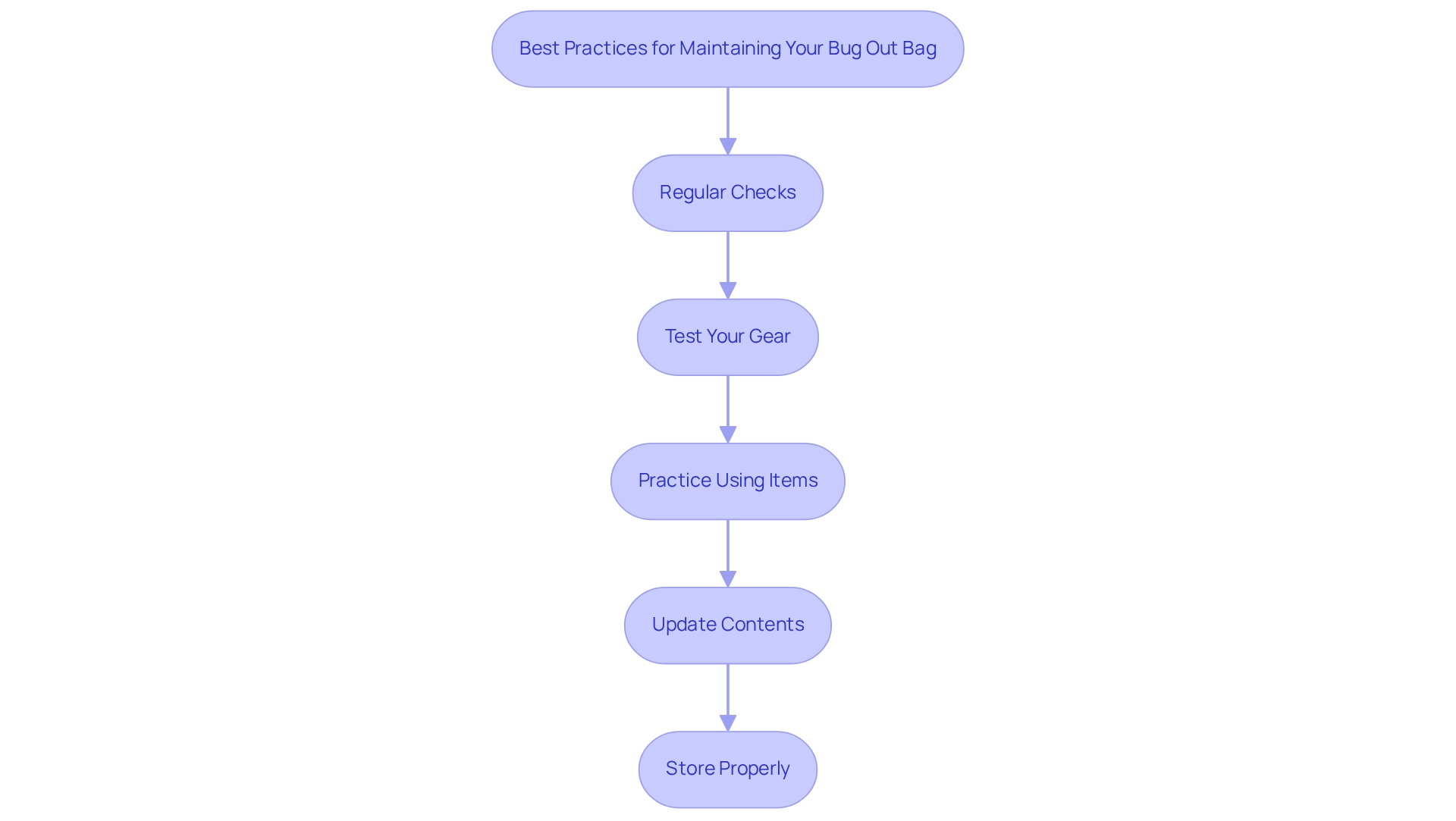
Each box represents a specific best practice, and arrows indicate the suggested sequence of actions to maintain and test your bug out bag.
7. Final Thoughts: Ensuring Your Preparedness with the Right Bug Out Bag
Having the right bug out bag is a crucial aspect of effective emergency planning. A well-equipped bug out bag is essential for providing necessary supplies and serves as a vital tool for enhancing your overall readiness. Understanding the purpose of a bug out bag, evaluating key factors in its selection, and exploring various types are foundational steps to purchasing one.
When packing your bag, prioritize essential gear tailored to your specific needs. Ensure it includes items that can sustain you in a crisis. Customizing your bag to reflect your individual situation and consistently organizing its contents are actions that significantly influence your readiness.
Statistics reveal that households with bug out bags demonstrate a higher level of preparedness. For instance, studies indicate individuals who have experienced prior disasters are more likely to take proactive measures. In Fall 2021, 56.0% of unemployed or retired individuals evacuated, highlighting the importance of being ready for crises.
Moreover, having a bug out bag can enhance response times during crises, enabling faster action when every second matters.
Mental and physical readiness is equally important in emergency situations. Experts emphasize that being psychologically prepared to act can make a significant difference in outcomes during crises. As Dr. Virginia Murray, a leading figure in natural hazards policy, highlights, "readiness encompasses both the physical supplies and the mental fortitude to utilize them effectively."
Including real-life instances of readiness strategies that involve how to buy bug out bags can further demonstrate their significance. For example, the case study titled 'Who is Getting Prepared?' reveals that while many express a desire to be prepared, a notable portion remains unprepared. This underscores the need for ongoing education and awareness in the preparedness community.
Ultimately, purchasing a bug out bag is not merely about gathering a collection of items; it represents a mindset of resilience and readiness crucial for navigating uncertain times.
Conclusion
A well-prepared bug out bag is not just a convenience; it is essential for effective emergency readiness, equipping you with the necessary supplies to navigate unexpected situations. Understanding its purpose, evaluating selection factors, and exploring different types are fundamental steps in establishing a solid preparedness plan.
When assembling your bag, prioritize essential gear tailored to your specific needs. This ensures it can sustain you during a crisis. Personalizing and regularly maintaining the contents enhances your overall preparedness. Research shows that households with bug out bags exhibit greater readiness, particularly among those who have experienced past disasters.
A properly stocked bug out bag facilitates quicker response times in emergencies, allowing for swift action when it matters most. Additionally, mental and physical readiness play a vital role, as psychological preparedness can significantly influence outcomes during crises.
Real-world examples underscore the importance of bug out bags in uncertain times. While many express a desire to be prepared, a notable portion remains unprepared. This highlights the need for continuous education and awareness within the preparedness community. Ultimately, a bug out bag is not merely a collection of items; it embodies a mindset of resilience and readiness, crucial for facing the challenges of an unpredictable world. Are you ready to take the next step in your preparedness journey?

Frequently Asked Questions
What is a bug out bag (BOB)?
A bug out bag is a portable kit designed to ensure survival for at least 72 hours during a crisis evacuation. It provides individuals with the necessary tools and resources to sustain themselves during a rapid departure from home due to situations like natural disasters or civil unrest.
What are the key features of a bug out bag?
Key features of a bug out bag include portability for easy transport, essential supplies such as food, water, and first aid items, and quick access organization for rapid retrieval of gear during emergencies.
Why is having a bug out bag important?
Having a bug out bag is important because it enhances personal safety and resilience during crises. Prepared individuals with well-stocked emergency kits often report smoother evacuation processes during critical situations.
What should I consider when selecting a bug out bag?
When selecting a bug out bag, consider size and capacity (40-60 liters for a 72-hour kit), durability (water-resistant materials and reinforced stitching), comfort (padded straps and hip belts), accessibility (front-loading compartments), and weight (a lightweight design to minimize strain).
How much should a bug out bag weigh?
A well-packed bug out bag should ideally weigh between 20 to 25 pounds to ensure it is manageable for quick escapes.
What types of supplies should be included in a bug out bag?
A bug out bag should include essential supplies such as food, water, first aid supplies, and personal items like prescription medications, tailored to individual needs.
What expert opinions support the need for a bug out bag?
Experts like Virginia Murray from Public Health England emphasize that a well-prepared bug out bag can significantly enhance personal safety during crises, highlighting its role in effective emergency preparedness.
